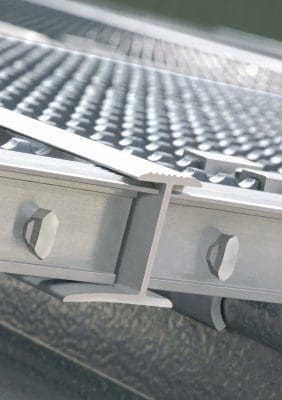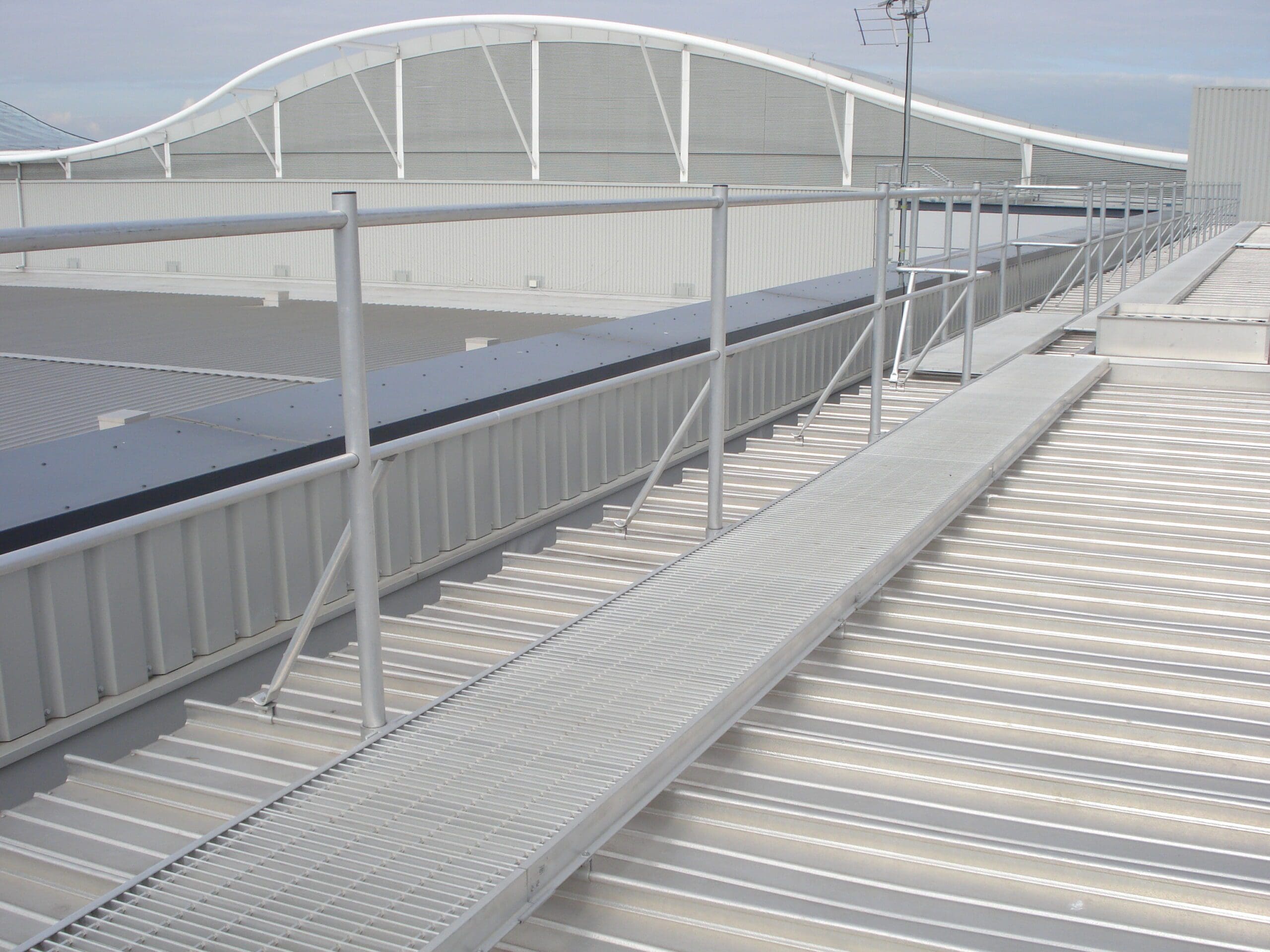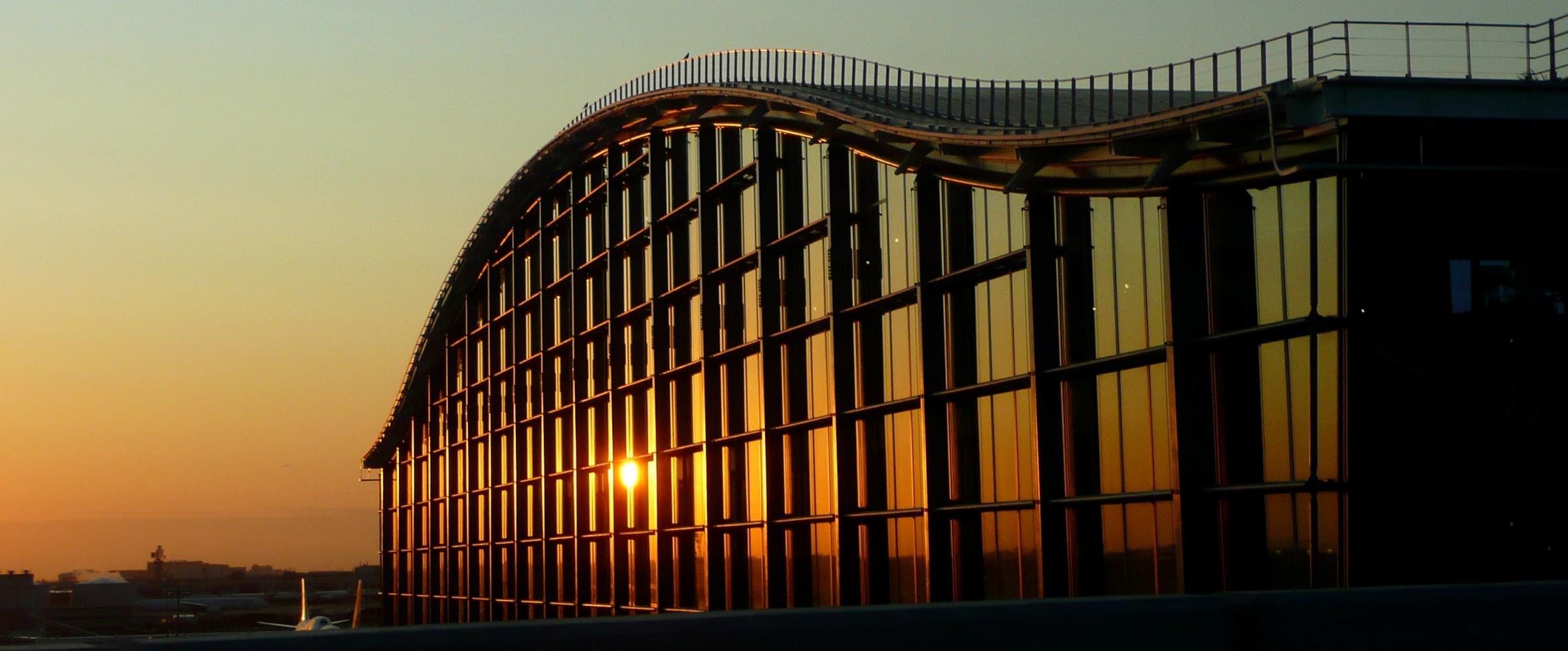A roof access walkway is a vital feature for many types of buildings. Measures that provide safe working at height, including fall protection, require careful consideration from architects, facilities managers and those tasked with the responsibility of site management. This article answers all the key questions regarding the correct design and installation of a roof walkway system.

DOES YOUR BUILDING NEED A ROOF WALKWAY SYSTEM?
The Construction (Design and Management) Regulations 2015 (CDM 2015) state that designers must eliminate, reduce or control the foreseeable risks involved in the construction phase. Once the building is complete, the regulations continue to apply to any risks involved in its future maintenance.
If a building requires regular access to the roof, it is legally required by CDM 2015 to provide a safe and level roof walkway system. Regular access is a common requirement on roofs with roof lights, commercial/industrial machinery, systems or equipment or solar panels which need regular servicing or maintenance.
Commercial and industrial buildings that require regular roof maintenance access are also subject to the Workplace (Health, Safety and Welfare) Regulations 1992 which state that:
“every floor, traffic route and walkway should not have holes or slopes, or be uneven or slippery, exposing people to health and safety risks.”
A safe and level roof access walkway as a clearly designated traffic path will satisfy these stipulations. Most roof surfaces are not primarily designed to handle foot traffic, so the provision of designated walkways can also eliminate pedestrian wear and tear of the roof.

WHAT IS REQUIRED TO PROVIDE SAFE ROOF ACCESS
If the roof is flat, then non-slip mats or grating panels may be sufficient as long as falls from the roof perimeter are prevented by simple edge protection arrangements (e.g. a secure guardrail and toeboard around the edge). However, if there is a degree of the sloping roof structure is not flat then a full roof access walkway solution is required.
Roof access walkway systems should be designed and constructed with compliance with European and OSHA legislation for safe working at height. If a property is inspected for insurance and other certifications, a roof access walkway built to these requirements can avoid any challenges by inspectors.
A roof walkway system should meet the load-bearing requirements contained in BS EN 516:2006 Prefabricated accessories for roofing-Installations for roof access-walkways, treads and steps. This states that the walkway should be tested with a load of 1.5Kn over an area 100mm squared and deflection kept within 15mm or 1/100 of the span, whichever is the lesser. The load will then be increased to 2.6kN and held for a minute. For other specifications consult requirements contained in BS EN 1991-1:2002.
Typical elements of a compliant roof access system include:
- A walkway which provides a slip-resistant surface (Figure “B”) and a clear demarcation route (Figure “A”) which uniformly distributes the pedestrian load across the surface.
- Ideally, the walkway should have a grille/mesh design to enable efficient drainage and prevent pooling of rainwater.
- A guardrail or handrail fixed to one or both sides of the walkway to provide additional safety. If the roofing substrate is fragile, rails can provide important fall protection, especially near a valley or parapet. For guidance consult BS EN 1991-1-1:2002 as the loading is dependent upon the protection required from the min 0.22 kN/m for walkways not more than 600mm wide.

WHAT ARE THE INSTALLATION REQUIREMENTS?
Non-penetrative fixing
Many industrial and commercial buildings feature ‘standing seam’ roofing – a style of roof that has panels running vertically up the length of the roof, and seams that connect one panel to another. A roof access walkway should have non-penetrative fixing system (eg. self-riveting seam clips or clamps) which can be secured to standing seam panels without piercing the sheet. This avoids creating a weakness in the roof’s waterproof membrane and increasing its vulnerability to leakage. For the same reason, if the walkway requires a fall protection guardrail, it helps to attach the rail to the side of the walkway rather than the roof surface.

Easy fitting
The elevated work required to install walkways means that hazards are inevitably heightened too. Therefore roof walkway should minimise manpower and time spent on installation modular construction/assembly system with panels and associated rails that are quick and easy to fit without hot works such as welding.
Design adaptability
If the roof is not flat it is important to ensure that the walkway has the technical capability to meet the demands. For example, curved, undulating or barrel roofing requires a walkway with a modular assembly that is versatile enough to adapt to its shape.
On sloped roofing, it is important to check that the walkway system can be installed on the roof’s degree of pitch.

WHAT ARE SUITABLE MATERIALS FOR ROOF WALKWAY SYSTEMS?
Roof walkways are generally manufactured from aluminium, Glass Reinforced Plastic (GRP) or steel. Aluminium has a number of compelling advantages over the other two materials:
- Aluminium is 1/3 of the weight of steel, providing easier handling and faster installation.
- Unlike steel, aluminium is non-corrosive and rust-free.
- Aluminium is much more durable than GRP – it’s stronger and retains its colour extremely well, unlike GRP which is bleached by UV rays.
- Aluminium scores higher in fire safety tests – it is A1 Fire Rated and fully compliant with Class 0 in Document B ‘Fire Safety.
- Aluminium can be finely machined to enable a surface which has outstanding anti-slip qualities.

SHOT 1 006
CONSULT A SPECIALIST FOR EXPERT ADVICE
There is no ‘one-size-fits-all’ solution when it comes to roof walkways and fall protection systems – all equipment must be specified on a case-by-case basis. Designing a roof access walkway requires specialist knowledge regarding the particular technical demands and it is helpful to consult specialist contractors and manufacturers regarding the particular needs of your building or project. When speaking directly to manufacturers, make sure they have the necessary expertise in this area to provide reliable advice and technical support, design consultation through to final installation.
Are you looking for Roof Walkway System? Contact us now and we can answer any questions you may have.


